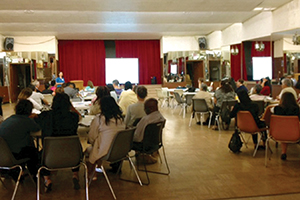IPM with a Focus on People
 |
|
Extension educators in Pennsylvania reached out to the Latino community with bilingual English-Spanish training about integrated pest management. Source: Lyn Garling |
When you think IPM, you might first picture agriculture, crops, and turf. Or perhaps insect biology and behavior. However, there’s an important human component: the social and cultural factors in the relationship between people and pests.
Pests often disproportionately affect minority populations and underserved communities. Poor housing conditions lead to chronic pest problems, compounded by (sometimes) unresponsive landlords, financial constraints, low levels of education and, in many cases, language barriers. This leaves these groups at high risk for poor pest management outcomes and increased pesticide exposures.
The IPM Program at Penn State is paying attention. They work extensively with the Hispanic or Latino population, the largest and fastest growing minority in the United States. Since 2013, the Northeastern IPM Center has funded their work with over $140,000 in grants for a number of related projects.
This group’s previous work on IPM in schools made them realize that to keep children—and families—healthy and pest-free, institutions needed to work on a community-wide approach.
“You can’t separate what happens at school from the home, the workplace, and other environments. You need to address all of them if you really want to succeed,” said Lyn Garling, program manager. “This is especially true in the case of bed bugs.”
They soon learned that urban IPM must deal with very complex social systems, with different situations and needs.
The Penn State group had to understand how the Hispanic community is organized, and address critical cultural and trust issues—not only the language. Much of their work is focused on developing and promoting culturally-effective IPM outreach and education. Creating partnerships across the community and with other institutions such as Rutgers University has been a key part of this process.
In addition to providing written materials in Spanish, they realized that people need a personal contact—someone they can trust, ask questions to, and who can show them how to access the right information.
“We learned to go into communities and develop personal relationships,” said Maria Gorgo-Gourovitch, the former Latino coordinator of the Philadelphia School and Community IPM Partnership. “It was a great process of mutual learning. We took this as a train-the-trainer opportunity. This way, we could increase the program’s impact and empower people.”
Such a proactive approach is one of the important lessons that this program has to offer.
“We have consciously developed programs, looked for funding, and gone out to do work and reach these communities,” said Ed Rajotte, IPM coordinator for Penn State Cooperative Extension. “It is not by mistake. You have to be intentional.”
—Dennise Belmaker
The Northeastern IPM Center promotes integrated pest management for reducing risks to human health and the environment. If republishing our news, please acknowledge the source (“From Northeast IPM Insights”) along with a link to our website.
